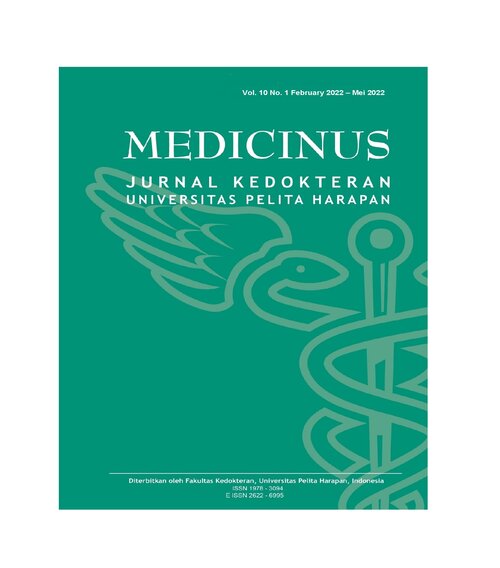Comparison of Early Postoperative Pain between Lightweight Mesh and Heavyweight Mesh in Lichtenstein Hernia Repair for Geriatric Patients at Rumah Sakit Siloam Karawaci from January 2018 - December 2019
DOI:
https://doi.org/10.19166/med.v10i1.6989Keywords:
Inguinal hernia, Complications, Heavyweight mesh, Lightweight meshAbstract
Background: Inguinal hernias are one of the most often cases in surgery. Inguinal hernias are usually found in males rather than females. There are two types of meshes in inguinal hernia repairs: heavyweight and lightweight mesh. There were still a lot of differences in the outcome of each mesh that was used. Therefore, with various different post operative pain results from past research, the author expresses an interest to conduct a research on this topic towards geriatric patients.
Methods: In this cross-sectional comparative study, 45 patients using heavyweight mesh and 45 patients using lightweight mesh herniorrhaphy with Lichtenstein technique in inguinal hernias at RS Siloam Karawaci Lippo Village and RSU were reviewed retrospectively. Patient's data were taken from medical record using purposive-sampling method. Early Postoperative pain on day 1 until 7 were classified following the Visual Analogue Scale (VAS). Incidence of postoperative infection and seroma were assessed in both groups. Collected samples will be processed using Pearson's Chi-Squared test.
Result: This study shows that there is a significant difference between the use of lightweight mesh in reducing moderate early postoperative pain for men above the age of 60 years old (p = 0.025) rather than the use of heavyweight mesh. Incidence of other postoperative complications such as infection and seroma have no statistically difference between both groups.
Conclusions: The use of lightweight mesh has the advantage in reducing early postoperative pain from herniorrhaphy using Lichtenstein technique rather than heavyweight mesh in men above 60 years old.References
1. Wu F, Zhang X, Liu Y, Cao D, Yu Y, Ma Y. Lightweight mesh versus heavyweight mesh for laparo-endoscopic inguinal hernia repair: a systematic review and meta-analysis. Vol. 24, Hernia. 2020. https://doi.org/10.1007/s10029-019-02016-5
2. Fitzgibbons RJ, Forse RA. Groin hernias in adults. N Engl J Med. 2014; https://doi.org/10.1056/NEJMcp1404068
3. Li J, Ji Z, Cheng T. Lightweight versus heavyweight in inguinal hernia repair: A meta-analysis. Hernia. 2012. https://doi.org/10.1007/s10029-012-0928-z
4. Ruhl CE, Everhart JE. Risk factors for inguinal hernia among adults in the US population. Am J Epidemiol. 2007. https://doi.org/10.1093/aje/kwm011
5. Bittner R, Arregui ME, Bisgaard T, Dudai M, Ferzli GS, Fitzgibbons RJ, et al. Guidelines for laparoscopic (TAPP) and endoscopic (TEP) treatment of inguinal hernia [International Endohernia Society (IEHS)]. In: Surgical endoscopy. 2011. https://doi.org/10.1007/s00464-011- 1799-6
6. Brown CN, Finch JG. Which mesh for hernia repair? Annals of the Royal College of Surgeons of England. 2010. https://doi.org/10.1308/003588410X12664192076296
7. Sanders DL, Nienhuijs S, Ziprin P, Miserez M, Gingell-Littlejohn M, Smeds S. Randomized clinical trial comparing self-gripping mesh with suture fixation of lightweight polypropylene mesh in open inguinal hernia repair. Br J Surg. 2014. https://doi.org/10.1002/bjs.9598
8. Öberg S, Andresen K, Rosenberg J. Absorbable Meshes in Inguinal Hernia Surgery: A Systematic Review and Meta-Analysis. Surgical Innovation. 2017. https://doi.org/10.1177/1553350617697849
9. Prakash P, Bansal VK, Misra MC, Babu D, Sagar R, Krishna A, et al. A prospective randomised controlled trial comparing chronic groin pain and quality of life in lightweight versus heavyweight polypropylene mesh in laparoscopic inguinal hernia repair. J Minim Access Surg. 2016.
10. Paajanen H. A single-surgeon randomized trial comparing three composite meshes on chronic pain after Lichtenstein hernia repair in local anesthesia. Hernia. 2007;11(4). https://doi.org/10.1007/s10029-007-0236-1
11. Demetrashvili Z, Khutsishvili K, Pipia I, Kenchadze G, Ekaladze E. Standard polypropylene mesh vs lightweight mesh for Lichtenstein repair of primary inguinal hernia: A randomized controlled trial. Int J Surg. 2014. https://doi.org/10.1016/j.ijsu.2014.10.025
12. Post S, Weiss B, Willer M, Neufang T, Lorenz D. Randomized clinical trial of lightweight composite mesh for Lichtenstein inguinal hernia repair. Br J Surg. 2004;91(1). https://doi.org/10.1002/bjs.4387
13. Uzzaman MM, Ratnasingham K, Ashraf N. Meta-analysis of randomized controlled trials comparing lightweight and heavyweight mesh for Lichtenstein inguinal hernia repair. Vol. 16, Hernia. 2012. https://doi.org/10.1007/s10029-012-0901-x
14. Sajid MS, Leaver C, Baig MK, Sains P. Lightweight versus Heavyweight mesh for open repair of inguinal hernia (Protocol). Cochrane Database Syst Rev. 2011. https://doi.org/10.1002/14651858.CD009495
15. Nikkolo C, Murruste M, Vaasna T, Seepter H, Tikk T, Lepner U. Three-year results of randomised clinical trial comparing lightweight mesh with heavyweight mesh for inguinal hernioplasty. Hernia. 2012;16(5). https://doi.org/10.1007/s10029-012-0951-0
16. As G, Medikeri AS. Comparison of Heavy- and Light-Weight Composite Mesh in Pain Reduction Among Patients with Inguinal Hernia: A 1-Year Randomized Control Trial. www.ijmrhs.com Int J Med Res Heal Sci. 2017.
17. Turculet CS, Ene D, Sacrieru D, Georgescu F, Ciuca E, Iordache F, et al. Inguinal hernia repair: Laparoscopic versus open Tehnique. Surg Endosc Other Interv Tech Conf 23rd Int Congr Eur Assoc Endosc Surgery, EAES 2015 Bucharest Rom Conf Start 20150603 Conf End 20150606 Conf Publ (. 2016.
Downloads
Published
How to Cite
Issue
Section
License
Copyright (c) 2023 Nicholas Axel Sidharta, Andry Irawan, Jeremia Immanuel Siregar, Nata Pratama Hardjo Lugito

This work is licensed under a Creative Commons Attribution-ShareAlike 4.0 International License.
Authors who publish with this journal agree to the following terms:
1) Authors retain copyright and grant the journal right of first publication with the work simultaneously licensed under a Creative Commons Attribution License (CC-BY-SA 4.0) that allows others to share the work with an acknowledgement of the work's authorship and initial publication in this journal.
2) Authors are able to enter into separate, additional contractual arrangements for the non-exclusive distribution of the journal's published version of the work (e.g., post it to an institutional repository or publish it in a book), with an acknowledgement of its initial publication in this journal.
3) Authors are permitted and encouraged to post their work online (e.g., in institutional repositories or on their website). The final published PDF should be used and bibliographic details that credit the publication in this journal should be included.





